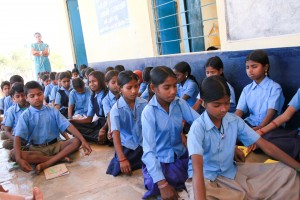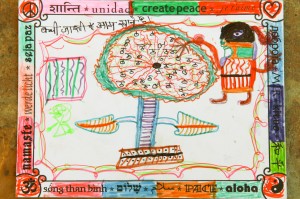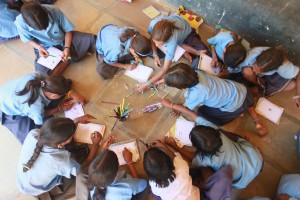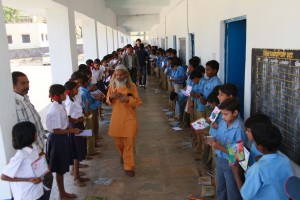Boys and Girls are often, and almost always, separated from each other. In nearly every workshop, boys are positioned on one side of the room and girls on the other. This has taken many forms and leaves me wanting to stand the kids up and mix the group, which I have done on a couple occasions. It’s almost certainly safe to say that after students reach age 8 they are divided by sex and positioned on opposite sides of the classroom.


The final phenomenon with Indian government schools is ATTENDANCE.
Attendance is the single most impact-ful issue facing the Indian masses incultivating advanced education. 1) Students seem to have zero requirement to attend school. This seems sensible since B) the teachers have an even worse attendance record than the students. So, in a country of a billion plus, with hundreds of thousands of schools, it’s understandable that there would be no structured way of keeping kids in school, and even so, in places where students do attend, who’s to say whether a teacher will show up on a given day, or week. I have witnessed all too many classrooms where there is no teacher and the students sitting quietly, somberly, by themselves on the cold stone floor – doing nothing. This is one sad issue and a problem that my lovely and passionate partner has been working for years to solve: how to get the teachers to the school, to teach the kids, and thus inspire the kids to attend and thus learn: a problem as endless as you can imagine in a country as massive as India.
And so it saddens me every time to arrive at a school and walk into classrooms to witness
20 plus youngsters seated on the floor, huddled together without guidance or instruction, seemingly staring at the wall, without an adult or teacher to inspire them
It’s not exactly prison, but it isn’t much of a school system either.

 The final phenomenon with Indian government schools is ATTENDANCE.
Attendance is the single most impact-ful issue facing the Indian masses incultivating advanced education. 1) Students seem to have zero requirement to attend school. This seems sensible since B) the teachers have an even worse attendance record than the students. So, in a country of a billion plus, with hundreds of thousands of schools, it’s understandable that there would be no structured way of keeping kids in school, and even so, in places where students do attend, who’s to say whether a teacher will show up on a given day, or week. I have witnessed all too many classrooms where there is no teacher and the students sitting quietly, somberly, by themselves on the cold stone floor – doing nothing. This is one sad issue and a problem that my lovely and passionate partner has been working for years to solve: how to get the teachers to the school, to teach the kids, and thus inspire the kids to attend and thus learn: a problem as endless as you can imagine in a country as massive as India.
And so it saddens me every time to arrive at a school and walk into classrooms to witness
20 plus youngsters seated on the floor, huddled together without guidance or instruction, seemingly staring at the wall, without an adult or teacher to inspire them
It’s not exactly prison, but it isn’t much of a school system either.
The final phenomenon with Indian government schools is ATTENDANCE.
Attendance is the single most impact-ful issue facing the Indian masses incultivating advanced education. 1) Students seem to have zero requirement to attend school. This seems sensible since B) the teachers have an even worse attendance record than the students. So, in a country of a billion plus, with hundreds of thousands of schools, it’s understandable that there would be no structured way of keeping kids in school, and even so, in places where students do attend, who’s to say whether a teacher will show up on a given day, or week. I have witnessed all too many classrooms where there is no teacher and the students sitting quietly, somberly, by themselves on the cold stone floor – doing nothing. This is one sad issue and a problem that my lovely and passionate partner has been working for years to solve: how to get the teachers to the school, to teach the kids, and thus inspire the kids to attend and thus learn: a problem as endless as you can imagine in a country as massive as India.
And so it saddens me every time to arrive at a school and walk into classrooms to witness
20 plus youngsters seated on the floor, huddled together without guidance or instruction, seemingly staring at the wall, without an adult or teacher to inspire them
It’s not exactly prison, but it isn’t much of a school system either.

























Recent Comments